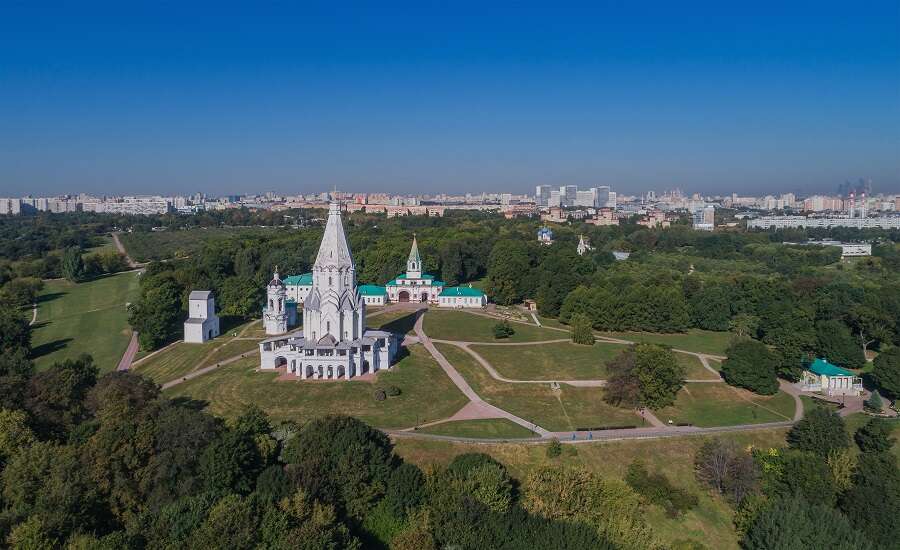
Photo by A.Savin on Wikimedia - Own work, CC BY-SA 3.0
Kolomenskoye Park is the perfect place to escape the hustle and bustle of Moscow, a picturesque oasis located less than an hour from the city center. Its rolling parkland is one of the most ancient sites in Moscow, once a royal estate belonging to the Grand Princes of Muscovy. Today, visitors can find a treasure trove of ethnographic, historical, architectural and natural wonders, including an open-air museum of Russian wooden architecture, a UNESCO-recognised church which set the stage for a century of Russian religious architecture, a palace once known as the ‘Eighth Wonder of the World’, and scenic parkland home to protected nature.
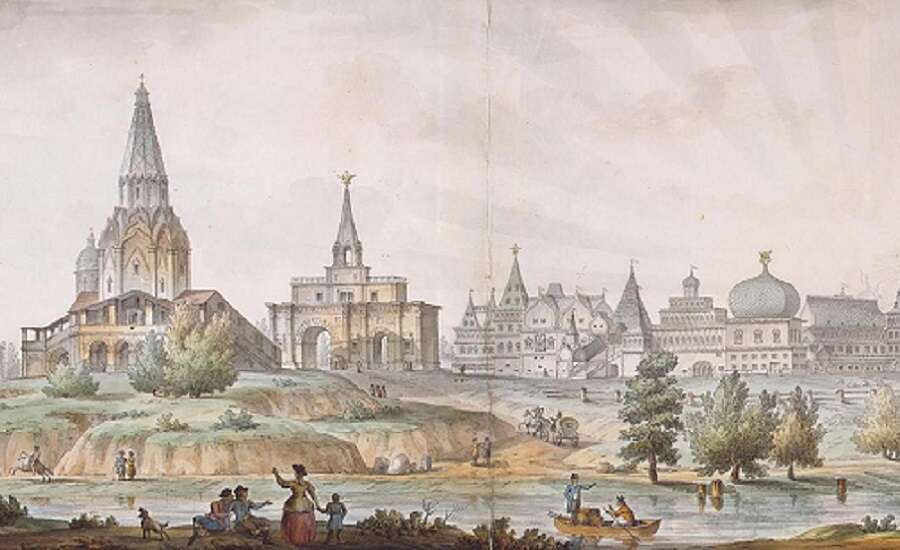
Photo by Giacomo Quarenghi - hermitagemuseum.org, Public Domain
Kolomenskoye is one of the most ancient inhabited sites in Moscow, with archaeological sites dating back to the Stone Age. In later centuries, tribes of Finno-Ugric peoples settled on this forested land bordered by the Moskva River. As the Grand Dukes of Muscovy expanded their reach throughout the land, the villages of Kolomenskoye and Dyakovo were developed into a royal country estate. Among the first buildings constructed here were the Ascension Church (built in 1532 to celebrate the birth of the future tsar, Ivan the Terrible) and the Church of John the Baptist (erected in 1547 in honour of Ivan’s ascension to the throne).
In the early days of the Romanov Dynasty (which succeeded the Rurikids in 1613), Kolomenskoye maintained its place as the favourite suburban palace of the tsars. During the rule of Tsar Alexei Mikhailovich, Kolomenskoye became a ceremonial residence where the tsar entertained foreign dignitaries and members of the religious and political elite. Alexei was responsible for building his beloved Kolomna Palace, a masterpiece of traditional Russian wooden architecture. The estate’s scenic landscape was filled with rich gardens to supply the royal kitchens with fresh herbs, fruits and berries, and thick forests where the tsars loved to hunt and relax.
Peter the Great spent some of his childhood in Kolomenskoye. However, he was not as enamoured with his ancestral country estate as his father, Alexei, was, abandoning Kolomenskoye for his new capital. Peter very rarely left St Petersburg to visit his family’s estate, leaving Kolomenskoye for the last time in May 1724. The estate gradually fell into disrepair and Catherine the Great even demolished the famous Kolomna Palace in favour of a more modest stone construction. Although Tsar Alexander I often visited Kolomenskoye with his grandmother, Catherine, he and his descendants had little interest in this decaying estate on the edges of Moscow, when they had glorious palaces to retreat to in the suburbs of St Petersburg. By the mid-19th century, royal court life ceased to exist at Kolomenskoye and the estate lay in ruins.
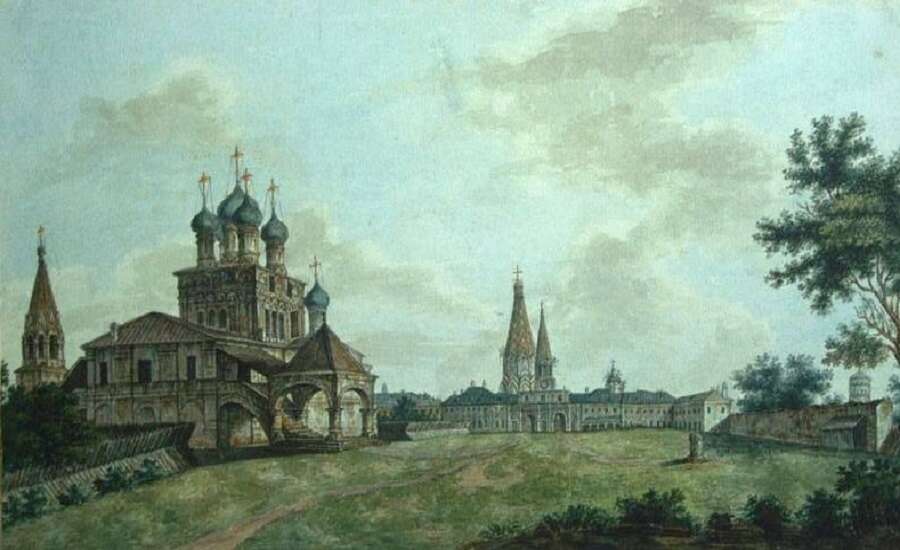
Image by Fyodor Alexeev on http://kagenid.narod.ru/9.html, Public Domain
Restoration work in Kolomenskoye began in 1913 and, despite the disruption of revolution and the Civil War, resumed a decade later on the initiative of Pyotr Baranovsky. An eminent architect and restorer, Baranovsky carried out restoration and research of Kolomenskoye’s ancient monuments. However, Baranovsky did not focus his attention on Kolomenskoye alone: he was passionate about preserving other masterpieces of Russian wooden architecture from bygone centuries. Thanks to his efforts, abandoned wooden monuments from all around the USSR were transported to Kolomenskoye for restoration and research purposes, forming the Museum of Wooden Architecture. The work begun by Baranovsky has continued up until the present day, and the 16th and 17th century buildings of the imperial estate have been restored to their former glory.
Today, Kolomenskoye has been transformed from an abandoned estate into an open-air complex of ethnographic, historical and architectural wonders, where visitors today can travel back in time. The different sections of Kolomenskoye – Ascension Square and Tsar’s Courtyard, the Museum of Wooden Architecture, and the Palace of Tsar Alexei Mikhailovich – are dotted throughout the parkland, allowing visitors not only to explore a treasure trove of history and culture, but to enjoy a walk in peaceful nature at the same time.
Ascension Church: One of the main attractions of the Kolomenskoye ensemble is this church, built in 1532 and recognised in 2004 as a UNESCO World Heritage Site. It was the first stone tent-roofed church in Russia and synthesised the most outstanding features of Byzantine, Gothic, Greek, Roman and ancient Russian architecture, setting the standard for religious architecture in Russia for the next century. The Ascension Church’s elegant facades are made from pure white stone, its octagonal tower comprises tiers of kokoshniks rising to a 62-metre bell tower, and galleries encircle the church. Perched high on a hilltop overlooking the Moskva River, the Ascension Church dominates the surrounding landscape. Inside is an exhibition about the church, its archaeology and restoration.
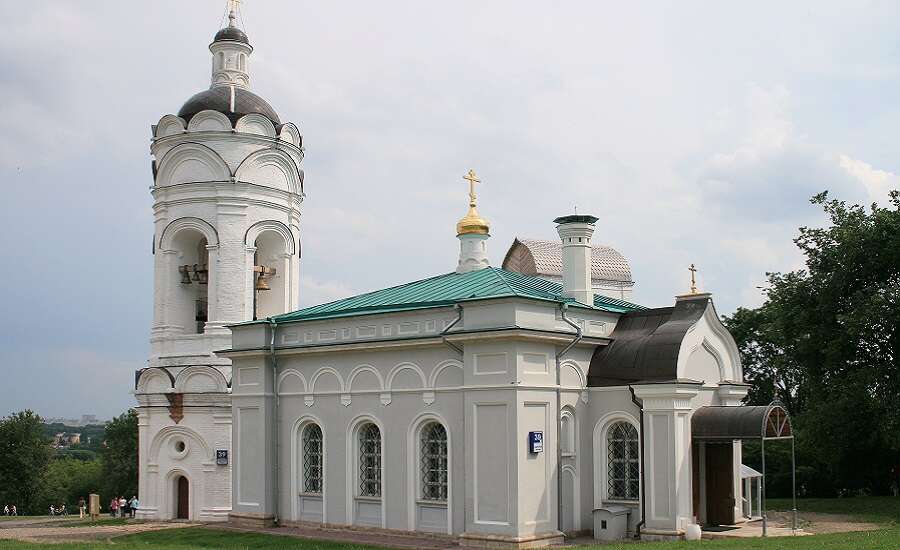
Photo by Ludvig14 on Wikimedia - Own work, CC BY-SA 3.0
Church of St George: A 16th century church with its bell tower, which has recently been restored. Every day except Mondays and Tuesdays, the bells are rung from 1:30pm – 3:30pm.
Water Tower: the royal residence of Kolomenskoye was supplied with water from this 17th-century tower. Inside you can find an exhibition about water supplies from the 17th-20th centuries.
Palace Pavilion: a palace was built here for Tsar Alexander I. Unfortunately, the tsar died before its construction was completed, and the palace was demolished in 1872. The pavilion is the only remaining part of Alexander’s palace, and various exhibitions are held here.
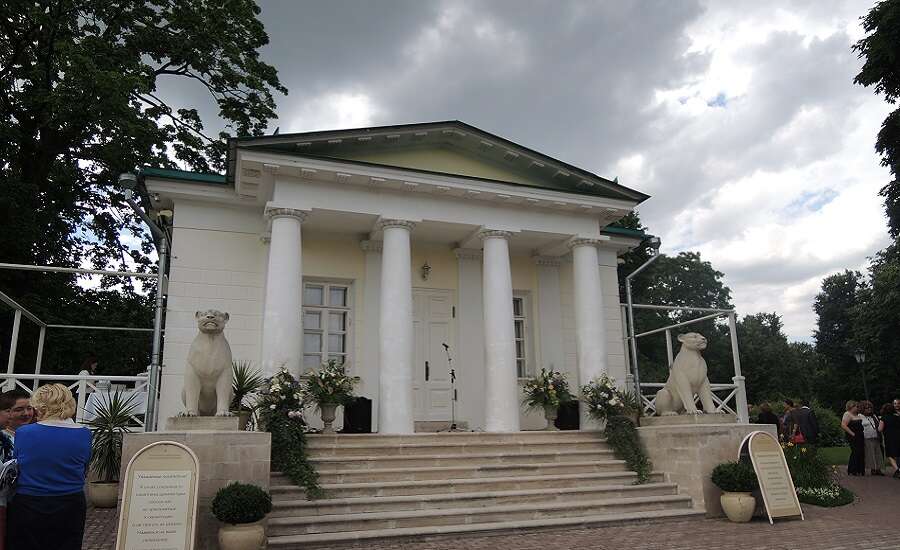
Photo by Shakko on Wikimedia - Own work, CC BY-SA 4.0
The Kolomna Palace of Tsar Alexei Mikhailovich was painstakingly reconstructed using documents, memoirs, drawings, paintings and models found in the archives and museums of Russia and Europe, and was finally reopened in 2010. Those who visited the palace back in Alexei’s era declared it to be a ‘paradise’ and the ‘Eighth Wonder of the World’ for its incomparable style, which was inspired by architecture in Europe and Pre-Petrine Russia. The exterior of the palace really is a crazy synthesis of architectural elements of all shapes and sizes, topped off with 26 green towers.
The interior of Alexei’s palace is ornate and colorful, decorated with period furniture and covered in paintings. The palace’s halls are filled with exhibitions about the life of the tsars as well as a rich and unique exposition, ‘Treasures of 17th century Russian art’, which showcases icons, paintings, drawings, wooden carvings, metalwork and decorative and applied art created by elite masters and folk artists.
Front Gate: separating the Ascension Square from the Tsar’s Courtyard is the Front Gate, built by Tsar Alexei Mikhailovich as the main entrance to his cherished summer estate. Inside this architectural monument is an exhibition ‘Milestones in the History of Kolomenskoye’.
Sytny Courtyard: its name quite suitably translates as ‘nourishing, satisfying’ courtyard – this building was used to prepare traditional Russian beverages such as beer, kvass (a fermented, very slightly alcoholic drink made from rye bread) and medovukha (an alcoholic drink similar to mead).
Church of Our Lady of Kazan: the first Romanov tsar, Mikhail Fyodorovich, ordered the construction of a wooden church here in the 1630s, which served as the personal church for the royal household. The church is aptly dedicated to the Kazan Icon, whom the Romanov family credited for helping them attain power. In the mid-1650s, the wooden church was replaced with the stone church we see today, its white stone walls crowned with several sky-blue domes.
House of Peter I: this wooden house was built in 1702 for Peter the Great, while he oversaw the construction of the Novodvinsk Fortress near Archangelsk on the White Sea. In 1934, it was transported from Archangelsk to Kolomenskoye. Today, it is home to Moscow’s only memorial exhibition dedicated to Peter the Great, set in early-18th century interiors. Entitled ‘Builder, Swimmer, Hero’, the exhibition tells the story of Peter’s rich array of interests.
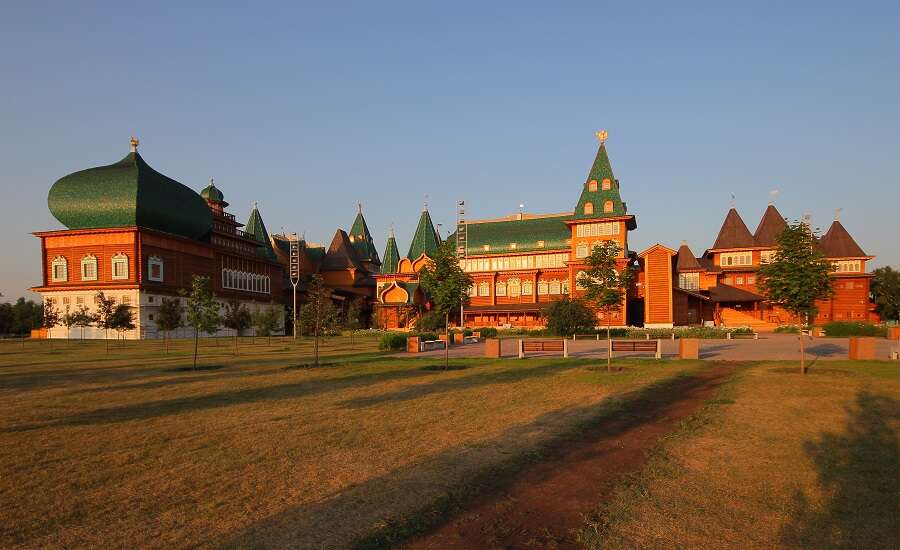
Photo by A.Savin on Wikimedia - Own work, CC BY-SA 3.0
The rest of Kolomenskoye’s wooden monuments are located in the Museum of Wooden Architecture founded by Pyotr Baranovsky.
Passage Tower of the Nikolo-Kerensky Monastery: relocated from the White Sea to Kolomenskoye, this tower is a magnificent example of 17th and 18th century carpentry technology and was rebuilt here with historical tools dating from its original period of construction.
Mokhovaya Tower of the Sumy Prison: a fortress prison built in the 16th century, home to an exhibition about the military and civilian inhabitants of the fortress, historical weapons, clothes and documents, and the history of the fortress and of the wider defence system of the Russian North.
Church of St George the Victorious: a unique wooden church crowned with three small domes, which was transported from the north of Russia. It has been comprehensively restored inside and out with the help of historical records, including its stucco decoration and religious paintings.
Here, you can learn about peasant life in Imperial Russia.
Blacksmith’s Farmstead: this farmstead includes a blacksmith’s house, and workshop where craftsmen give demonstrations of their trade and make souvenirs which visitors can buy in the gift shop.
Kolomenskoye Peasant’s Farm: here you can learn about the traditional set-up of peasant life, and visit the house, outbuildings, and pens for animals.
Beekeeper’s Farm: the abundant gardens of Kolomenskoye made this the perfect place to produce honey. The beekeeper’s farmland is rich with fruit trees, herbs and flowers, and the house is home to exhibitions introducing the history of beekeeping and the life of a peasant beekeeper.
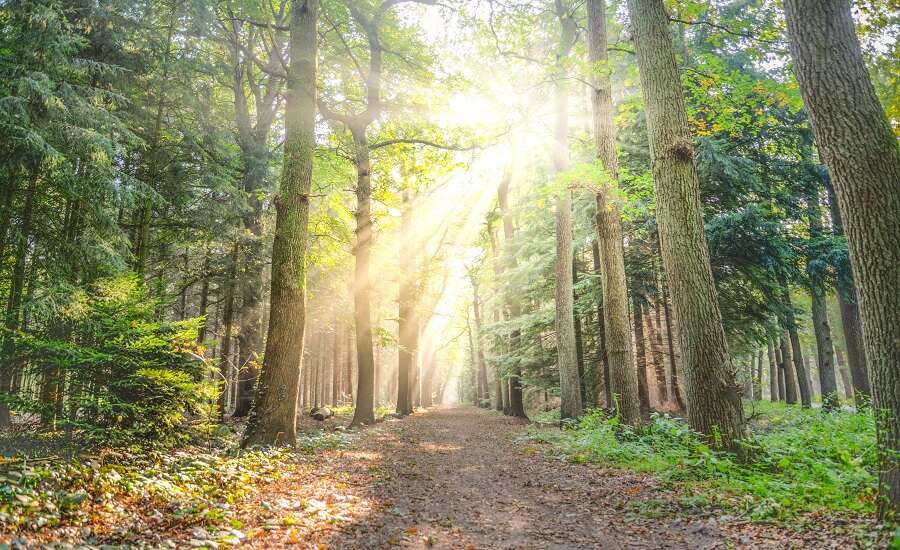
The 390-hectare Kolomenskoye Park is home to 10 specially-protected natural territories, among them a deep ravine, springs, Kolomna Oaks, ash trees and willow trees. The six historical gardens of Kolomenskoye have been restored to their 18th-century beauty, along with their fruit trees (although eating the fruit is forbidden, as the soil is contaminated with heavy metals). Aside from the royal gardens and orchards, Kolomenskoye Park is woven with woodland paths to be explored by foot or on rented bicycles, and is bounded by the wide Moskva River, where visitors can enjoy a serene summer’s walk and take in the forested scenery or take a boat from the Kolomenskoye Pier.
Address and contact details
Prospekt Andropova, 39, Moscow, 115487
Website: http://mgomz.com/
Email: mgomz@culture.mos.ru / GolovizninaAV@culture.mos.ru (excursions in the Palace of Tsar Alexei Mikhailovich)
Phone: +7 (499) 615-27-68 / +7 (499) 615-27-71 (other excursions in Kolomenskoye)
Nearest metro: the closest metro station to the Palace of Tsar Alexei Mikhailovich is Kashirskaya (650m walk to entrance no.5). The closest station to the Ethnographic Centre and Museum of Wooden Architecture is Kolomenskaya (800m walk to entrance no.2). Ascension Square lies 1.5km from Kolomenskaya and 2.3km from Kashirskaya.
Opening hours and tickets
Kolomenskoye Park is open every day from 6am to midnight.
The opening hours of Kolomenskoye’s museums, monuments and souvenir shops can be found here.
Ticket prices for the different attractions in Kolomenskoye can be found here.
Join us on Facebook
We invite you to become a fan of our company on Facebook and read Russian news and travel stories. To become a fan, click here.
Join our own Russian Travel, Culture and Literature Club on Facebook. The club was created to be a place for everyone with an interest in Russia to get to know each other and share experiences, stories, pictures and advice. To join our club, please follow this link.